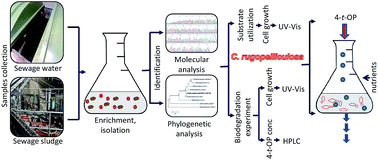Aerobic degradation of estrogenic alkylphenols by yeasts isolated from a sewage treatment plant
Abstract
Long-chain alkylphenols including octylphenol (OP) are well-known toxic pollutants prevailing in the environment due to the massive demand of these chemicals in industry and have been identified as endocrine disrupting chemicals (EDCs). While a considerable amount of work has addressed the degradation capacity of EDCs carried out by bacterial and filamentous fungal strains, little is known about the EDC degradation by yeasts. In this study, we isolated three branched-chain OP-degrading yeast strains from samples collected from a wastewater treatment plant in Taipei, Taiwan, by enrichment methods using 4-t-octylphenol (4-t-OP) as the sole carbon and energy source. Analysis of ITS and LSU rDNA gene sequences revealed that these isolates belonged to two genera and were designated as Candida rugopelliculosa RRKY5, Galactomyces candidum RRK17 and G. candidum RRK22. Growth properties of the isolates were explored using different substrates such as 4-t-OP, 4-t-nonylphenol (4-t-NP), octylphenol polyethoxylates (OPEOn), nonylphenol polyethoxylates (NPEOn), phenol and isooctane. Of these three, the strain RRKY5 utilized a wide variety of substrates and grew faster than the others. Results of HPLC analysis indicated that 4-t-OP degradation took place both in the presence and absence of the co-substrate dextrose (0.05%): within 24 days, 93% or 95% of 4-t-OP was degraded by C. rugopelliculosa RRKY5 in media with or without dextrose, whereas degradation was lower (less than 75%) in the two strains of G. candidum. Therefore, in contrast to the 4-t-OP degradation by filamentous ligninolytic fungi, dextrose did not appear to exert a significant impact on this process in yeast cultures. It can be concluded that RRKY5 is a potent candidate for the biodegradation of 4-t-OP and thus can potentially be used for bio-remedial actions in the future. To our knowledge, this is the first evidence demonstrating that pure cultures of yeast strains are capable of utilizing branched-chain OP.


 Please wait while we load your content...
Please wait while we load your content...